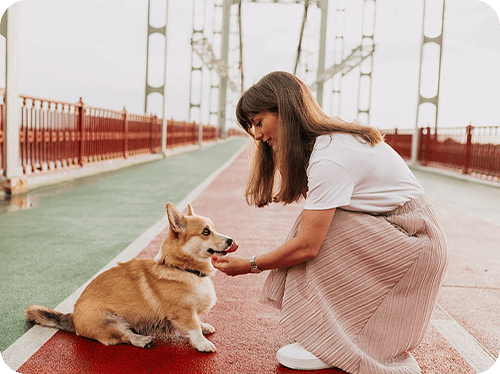Pets are beloved members of many households, providing their owners with companionship, love, and joy. Pets, on the other hand, have distinct personalities and behaviours that may be both interesting and difficult for pet owners to understand. In this blog, we will look at pet behaviour and what it means.

Body Language & Personalities
Pets, like people, express their moods and emotions through body language. Dogs wag their tails to express happiness and enthusiasm, whereas cats twitch their tails to express irritation or annoyance. Paying attention to your pet’s body language can help you better understand his or her attitude and feelings.
Social interactions
Pets are sociable creatures with their own distinct social habits. Dogs, for example, are pack animals that thrive in social environments with their owners and other canines. Cats, on the other hand, are solitary animals who prefer to spend the majority of their time alone. Knowing your pet’s behavioural patterns can assist you in providing the appropriate social environment for them.
Aggression
Aggression is a typical behaviour in pets, and it can be driven by a variety of circumstances like as fear, pain, or territorial instincts. Aggressive behaviour in pets can be dangerous, therefore it’s critical to handle it as soon as possible. If your pet exhibits aggressive behaviour, seek the advice of a veterinarian or animal behaviourist.
Biting–
A dog’s bite is motivated by three emotions: fear, anger, and anxiety. To avoid a bite, you must first learn to read and interpret canine body language. The dog sends out warning signals before launching into a full-fledged attack/bite. Aggression manifests itself as a dog showing off its fangs, making direct eye contact with the person it intends to attack, and growling with raised hackles. Other indicators to look for include the pet’s pinned up ears or upright tail. Young pooches/puppies nip to communicate with their human parents, but the mouth is utilized for interaction. Nipping behavior in puppies is sometimes caused by playfulness.
Noting responses to stimuli-
Dogs’ responses to stimuli can be extremely different. Each dog will react differently to the same stimuli depending on breed, size, and personality. When it comes to loud noises, for example, some dogs may be timid and shy away, while others may become enthusiastic and yelp. When it comes to being around people, some dogs are sociable and welcoming, while others are aloof and uninterested. Furthermore, when met with unknown objects, some dogs may be intrigued and investigate, whilst others may get fearful and retreat.
Also read:- Do You Know Best 5 Reasons Why Tailored Nutrition Is Beneficial In Pet Diets
Anxiety about separation–
Separation anxiety is a typical phenomenon among pets, especially dogs. When their owners leave them alone, pets suffering from separation anxiety may become destructive or overly obsessive. Separation anxiety can be decreased by offering your pets with mental and physical stimulation, including such puzzle toys and playtime.
Petzsetgo offers the highest-quality toys for your beloved pets that are experiencing separation anxiety from you. Toys help our pets learn and keep them from becoming bored or unhappy. Knowing which toy serves which purpose is crucial. Petzsetgo will help you understand the perfect toy for your pet type, just as you would pick the proper set of toys for your kid.
Vocalizations–
To communicate with their owners, pets employ vocalisations such as barking, meowing, and purring. Dogs, for example, may bark to warn their owners of impending danger, while cats may meow to request food or attention. Knowing your pet’s vocalisations might assist you understand their needs and desires.
Training–
Training plays a crucial role in the development of pet behaviour and may help mould your pet’s personality and behaviour. Positive reinforcement training, in which positive conduct is awarded, can help reinforce good behaviour in pets.
Ultimately, pets have unique behaviour, and understanding it may help pet owners offer the best environment and care for their pets. Paying attention to your pet’s body language, social behaviour, aggressiveness, separation anxiety, vocalisations, and training will assist you in better understanding your pet and developing a strong and healthy relationship with them.
Analyzing Playful Behaviors-
Awareness and loving our canine pets requires an awareness of their playful behavior. Dogs who are relaxed will frequently exhibit lively behavior such as barking, racing about, and chasing toys. This behavior is frequently observed in dogs when they are experiencing good emotions such as enthusiasm, happiness, or contentment. Studying dogs’ playful behavior can provide significant information into our animal friends’ emotional states. For example, increased activity levels in a dog while playing with toys could indicate enthusiasm or delight.
Observing Changes in Appetite-
It is critical to be aware of changes in your pet’s appetite, especially if it is a valued pet like a dog or cat. Because our canine companions cannot communicate with us, it is up to us to be aware of any changes in their behavior. A abrupt change in appetite is one sign that something is awry. If a dog is typically very excited about mealtime and suddenly stops eating or eats much less, this could be a symptom of an underlying problem. It’s also critical to keep an eye out for any changes in the type of food a dog is eating.
Conclusion–
Finally, it is critical to understand your pet’s common habits and how they communicate with us. This can assist us in better understanding our pet’s needs and providing the best care possible. You can guarantee that your pet is happy, healthy, and well-cared for by learning how to decode your pet’s behaviors. Finally, knowing their actions and maintaining a loving relationship will only strengthen the tie between pet and owner.
For More info & for other you can visit here as well!





